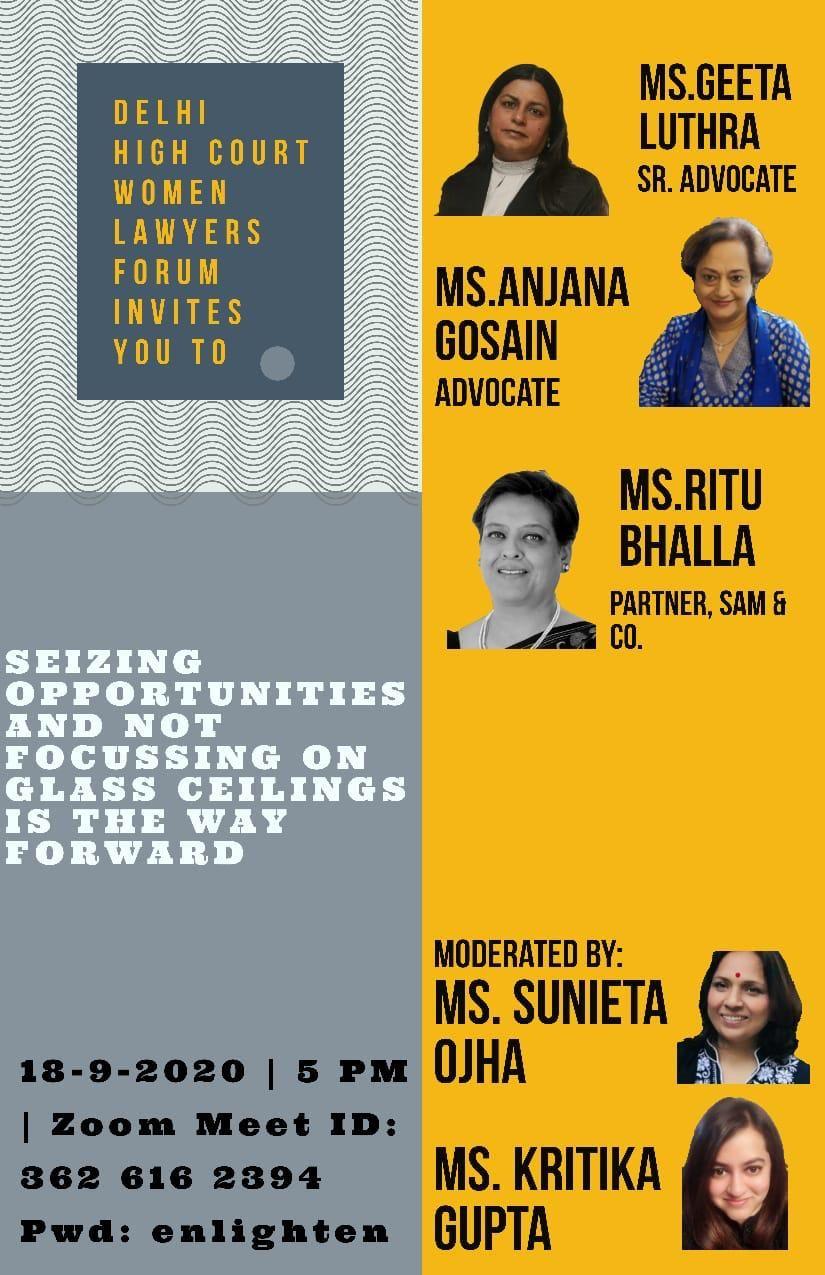Can Women Lawyers Break the Glass Ceiling in Indian Courts?

The legal fraternity is largely seen as a male bastion with little space for women. Of course, things have changed phenomenally over the years since 1923 when Regina Das’s application for enrolment was rejected by two High Courts of India on grounds of gender.
Over the years, the profession has witnessed stellar women lawyers and judges who have entrenched their names in Indian legal history. Yet, the question remains: Do women lawyers face a glass ceiling and how do they overcome it?
Hoping to address this critical aspect and help women lawyers succeed in the legal profession, Delhi Women Lawyers Forum organised its ‘Virtual Canteen’ session on ‘Seizing opportunities and not focusing on the glass ceilings is the way forward’ on September 18.
Senior Advocate Geeta Luthra, Advocate Anjana Gosain and Ritu Bhalla, partner at SAM & Co., inspired the audience at the webinar by recounting their journeys and wisdom on navigating the hurdles of the legal profession.
The glass ceiling is somewhere in between and not on the top
Speaking with The Leaflet, Advocate Sunieta Ojha, the moderator of the session, said, “ Their presence itself speaks for their journey. That they haven’t looked at the glass ceiling and moved forward. Litigation has not been seen as a preferred choice for women. Until 30-40 years ago, women had to really prove their mettle. All the speakers have done fabulously for themselves. We want to explore their journeys and inspire more.”
Geeta Luthra held the view “Don’t go by numbers and that the numbers are less. We feel this way because women entered the law field much later somewhere around the 70s or so. You have to see the evolution from that time till now. We are going to do much better than we have done till now.”
Ritu Bhalla candidly said, “I really wish I had a jaw-dropping and an eye-popping story of struggle. But if I say that I have such a story then I’ll be undermining the years of struggle by generations of women before me who shattered the glass ceiling and put it so far above that its existence is really not visible.”
Ojha had outlined the role of personal glass ceilings as a critical area that women lawyers face. “Some hurdles are institutional and some are personal. Clients sometimes prefer male lawyers. Women also have to address the factors of marriage and motherhood when looking at their legal careers. This is a space where if you take a break for a few months then you are out of sight and out of mind. Some people have small glass ceilings of their own in their own personal fronts,” said Ojha.
But there were individual biases which I prefer to call as glass canopies. But the wonderful thing about a canopy is that they have four ways to exit
Resonating with this, Ritu Bhalla said, “There were no institutional biases and no institutional sponsored glass ceiling. But there were individual biases which I prefer to call as glass canopies. But the wonderful thing about a canopy is that they have four ways to exit!”
“Glass ceiling is something which you have to consider. Every person gets an opportunity and only you have recognised it. You have to see the opportunity and accept it and learn to use it in the way you want,” said Gosain.

(Event poster, Source: Delhi Women Lawyers Forum)
All speakers acknowledged the crucial role that supportive families- parents, in-laws, husband, and children play in the success of a woman’s career. Gosain quipped, “I told my husband when we got married that you are going to be the second spouse because I felt so strongly about my profession.”
Many feel that India is lagging behind in walking the talk on women representation when compared to other countries. However, Ritu Bhalla pointed out, “Internationally, women may be a couple of decades ahead of us but at the end of the day the problem of women professionals is universal.”
So, whilst we are working very hard at our briefs we forget to plan our careers as senior counsels, we forget to plan our careers as a judge and we forget to plan our position as a partner in a law firm.
Yet, there is a difference in the environment between India and other countries, and one can’t help but wonder what is it that makes the two so different? “The distinction is between doing our jobs and planning our careers. So, whilst we are working very hard at our briefs we forget to plan our careers as senior counsels, we forget to plan our careers as a judge and we forget to plan our position as a partner in a law firm. The second thing is the tiara complex. The entire town, from the baker to the load of bread, knows if a man gets an obscure award. We on the other hand wait for somebody to look for us and put out that tiara on our heads,” said Bhalla.
Geeta Luthra concurred and advised young women lawyers, “You must all learn from our mistakes. Don’t sit in a comfort zone just because it is a comfort zone. Think of a career. You should balance all these things. You are doing a much more balancing act than any man would ever do.”
Today, almost half the enrolled students in law schools comprise of young girls aspiring to make their mark in the legal profession. On the large number of women joining the bar, Ojha asks, “How will the bar and judiciary respond to that?”
You must all learn from our mistakes. Don’t sit in a comfort zone just because it is a comfort zone.
She added “Judiciary has been at the forefront as an institution that has helped women push boundaries in other areas through judgments like Vishaka, Muthamma and Nargesh Mirza. But within the judiciary, changes in the bar and bench have been slow.”
Advocate Kritika Gupta, moderator of the session, noted the abysmal statistics on women representation as judges in High Courts and in Senior Designations. “The Hon’ble Law Minister was asked about the representation of women in the judiciary. The answer to this question was a little startling because women were a mere 7.2 percent in higher judiciary. If we take a look at the senior designations of the Supreme Court, only 13 women have made the cut and for Delhi High Court only nine women out of the 237 senior designations.”
Institutional reforms to move some change in the atmosphere are the need of the hour. “We are not saying that women need special treatment. It is just about enabling infrastructure like creches. The bar has never seen this as an important issue even though most women disappear. The glass ceiling is somewhere in between and not on the top,” Ojha said.
Yet, one can’t help but notice the change over the years. While the session began with recollection of lack of washrooms in the earlier days. it ended with the need for creches as infrastructural support for women lawyers.
The times, they are a changin’.
Women have indeed come a long way and, as Geeta Luthra said, women are going to do even better in the days to come.
(Megha Katheria is a socio-legal researcher and a Sub Editor at The Leaflet)
Originally Published in The Leaflet.
Get the latest reports & analysis with people's perspective on Protests, movements & deep analytical videos, discussions of the current affairs in your Telegram app. Subscribe to NewsClick's Telegram channel & get Real-Time updates on stories, as they get published on our website.
























